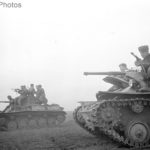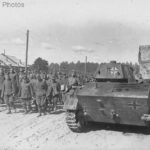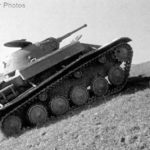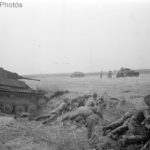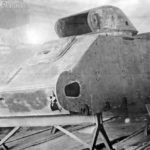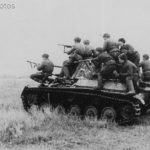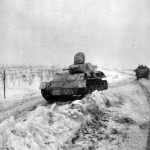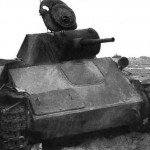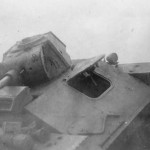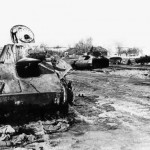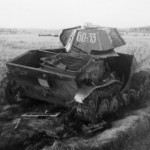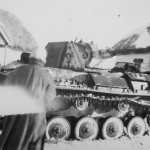T-70 passes a blown apart german Panzer IV Ausf G Summer 1943
T-70 of the 5th Guard Tank Corps 2
Tank crew sleep near their T-70
T-70 loaded onto a rail car for transport
German prisoners and ex-german T-70 near Kiev August 16, 1944
Column of T-70 tanks 18 January 1944
T-70M tanks from 19th Tank Corps, Crimea 1944
German prisoners and ex-german T-70 near Kiev August 16, 1944 2
T-70 of the 3rd Ukrainian Front 1944
Prototype of T-70: GAZ-70, 1942
Soviet T-70 and Troops of the 5th Guard Tank Corps
Soldier in T-70 waits in ambush near Voronezh District 1943
T-70 assembly at Zavod 38, Kirov
Whitewashed T-70 tank “38” Leningrad Front January 1944
Russian troops riding on the T-70 tank, 1942
German T-70
T-70 in Stalingrad 1942/43
German T-70 of the 46. Infanterie-Division
T-70 with winter camoflage
captured soviet light tank T-70 – Panzerkampfwagen T-70 743 (r)
Destroyed T-70 tank 5
Abandoned light tank T-70, Eastern Front 1942-1943
T-70 tanks in german service, 98. Infanterie-Division
German light tank Panzerkampfwagen T-70 743 (r)
The charred remnants of a Russian light tank T-70 1
T-70 tank soviet light tank 122
T-70 tank soviet light tank 2
Destroyed light tank T-70
Destroyed T-70 tank, Eastern Front Winter 1943-1944
Soviet light tank T-70 coded 60-33 destroyed by internal explosion
T-70 tank soviet light tank 329
German soldier examine an destroyed T-70 tank stucked in a mud
T-70 tank soviet light tank
Rear view of the T-70. The tank was completely destroyed.
T-70 captured soviet light tank – beute tank with balkenkreuz
T-70 — Soviet light tank of the Second World War, developed in October – November 1941 at the Gorky Automobile Plant ( ГАЗ – Го́рьковский автомоби́льный заво́д; GAZ – Gorkovsky Avtomobilny Zavod ) under the leadership of Nikolai Alexandrovich Astrov, a leading developer in the Russian line of light tanks of the period. In January 1942, T-70 was adopted by Red Army and serially produced in several plants. Production of the T-70 was continued until October 1943, when as a result of the fighting this Summer, and a great need for the Red Army in the self-propelled artillery units SU-76 at its base, it was decided to terminate its serial production.
Since the summer of 1942, light tanks T-70 took an active part in the battles of the WW2 on Eastern Front. The apogee of their military service became the Battle of Kursk, after which they began to disappear from the Red Army, although some tanks were used until the end of the war. As the number of issued, T-70 machine was the second largest type of tanks in the Red Army in 1941-1945. Based on the T-70 in late 1942 was built light self-propelled gun for direct support of the infantry, SU-76, a series of prototypes of light tanks with better armament or ergonomics and prototypes of the anti-aircraft tanks. Shortly after the end of war T-70 was withdrawn from Soviet army. Quite a large number of these tanks were preserved in military museums and memorials in Russia.
History
In September 1941 for the Red Army was adopted light tank T-60 constructed by A. Astrov, and at several plants have been deployed mass production of a new tank. Among these plants was the GAZ, production capacity which would allow the release of more serious combat characteristics of tanks than the T-60. After a small batch release of a number of small amphibious tanks at the end of the 1930’s the GAZ tank was not engaged, but a number of its employees already had some experience in this area. To assist in the organization of production of light tanks of GAZ was directed N. A. Astrov, who immediately joined in the work on strengthening of designs of the T-60, using the potential of the GAZ.
Based on their preliminary design from September 1941 Astrov, together with the staff of the design bureau of GAZ in October of that year began work on the design of the “upgraded T-60″. The main directions of modernization was strengthening the armament and increasing the power of the power unit of the machine. As a solution to the last problem involved a “spark” of the two engines GAZ-202 70hp each, series-connected with each other. The power plant managed to place in the hull of the same layout scheme, that of the T-60, but the length of engine required lengthening the hull and adding a fifth track wheel. The main armament of the upgraded tank provided a slightly modified 45 mm tank gun 20-K.
The designing of this tank watched the country’s top leadership headed by Stalin and hurried designers with the execution of the task. The prototype of the new tank of GAZ-70 (design designation 070 or 0-70) was collected on 14 February 1942 and sent to Moscow for demonstration and testing, which began on the 20th of the same month.
GAZ-70 has not made much of an impression on the military experts of the Red Army: almost equivalent to the T-60 one man turret. However, N. A. Astrov promised as soon as possible to eliminate the shortcomings identified in the tests. The fastest way is able to make a reservation – the thickness of the forehead of the new machine was adjusted to 45 mm in the lower front part and 35 mm – at the top.
On March 6, 1942 by decree No. 1394ss of GKO signed by Stalin, the new tank was accepted into service of the Red Army. In the same document contained the order for the GAZ to start serial production of T-70 at the address identified deficiencies in the design, and the subsequent three days GKO decree No. 1417ss for serial production of T-70 were connected factories No. 37 and No. 38. Because cast tower demonstrated poor resistance even to the fire of German 20mm guns, and thickening her armor was impossible for a number of constructive and productive causes, the T-70 was equipped with a welded hexagonal turret.
More difficult was the case with the two man turret. Although N. A. Astrov and his staff immediately, in April 1942, deals with the issue quickly to resolve it failed. The design of the new turret a special difficulty was not, but already at the stage of preliminary design, it became clear that its installation will weight the tank to 10.5-11.5 tons. Although the standard “spark” GAZ-203 with 140 hp provided the machine power density of 12.2 and 13.3 hp/t more than T-60 (10-11 hp/t), caused great doubt about the reliability of the chassis, inherited from the T-60. Test loaded to 11.5 tons T-70 confirmed the fears — break tracks, burst torsion bar suspension, quickly wore rubber bands of rollers in harsh environments easily damaged components and transmission, working harder due to increased resistance to movement of the heavier tank. Therefore, the main work has developed in terms of enhancing details and tank units, not be strong enough, and also forcing the power unit to 170 hp in August — October 1942, all the necessary components (engine, new turret, reinforced chassis) was tested on the experimental version of the T-70, which was recommended to be adopted for the Red Army. However, this was never done, and in the design of mass-produced T-70 decided to make a change on only heavy duty suspension. This modification received the designation T-70M and from the beginning of October 1942, was put into series production at GAZ and the plant No. 38. Apparently, the reason for the refusal of the production of T-70 with a two man turret served as preparation for serial production of improved light tank T-80, which was a further development of T-70 with all the requirements on ergonomics, power availability and armor of the latter.
Also, the T-70 formed the basis for the development of a large number of experienced light tank with enhanced armament, self-propelled guns (SU-76) and anti-aircraft guns (ZSU-37)
In the process of serial production of light tank T-70 was involved not only GAZ, but many other plants. Hulls for T-70 supplied the plants in Vyksa, Kulebaki and Saratov. Mechanical parts, optics, armament, electrical and instrumentation subcontractors has performed a large number of factories in Gorky region and other regions of the USSR. Compared to the T-60 light tank required twice as many engines, a thicker (i.e. more difficult and time consuming to manufacture) armor, so initially, with plans to release T-70 handle only GAZ. Factory No. 38 in Kirov came to the government’s level of production only in June 1942. The factory No 37 in Sverdlovsk was able to produce only 10 T-70, then due to manufacturing and capacity limitations for this assignment did not return, continuing to produce the T-60. Most of the T-70 was released on the GAZ, and the total number released T-70 could be even bigger, but before the battle of Kursk, the Germans made several deep air raids for Gorky. The purpose of these raids was various plants and objects of infrastructure of the city, which, despite the presence of aircraft factory No. 21, had no interceptors in the air defense system, which included a blackout and anti-aircraft batteries. The latter was concentrated mainly in the strategically important points features bridge across the Oka and the Volga river and the administrative center of the city, industrial zones are protected are much weaker. As a result, most of the damage occurred in the well-known Germans industrial part of city (bridges was not hit, historical part of the city was hit by a single bomb). In the first place hit GAZ, which lost almost half the units of their equipment.
GAZ has sharply reduced its production. Had to suspend production of trucks and armored cars BA-64, but production of T-70 was continued.
As a result of the Battle of Kursk in the country’s leadership, the prevailing view that the light tank T-70 is no longer needed for the Red Army. The emphasis has shifted towards the SU-76M on its base. Therefore, in October 1943 the production of T-70 was officially completed, although some more time T-70 were delivered to the troops at the expense of previously established a reserve hulls.
In the course of the production of T-70 in the manufacturing process changes have been made, for example, initially homogeneous armor steel for the tank to expose the surface hardening method, developed by technologists of the plant number 264 in the city Sarepta.
Armor of the tank body welded from rolled armor thick plates 6, 10, 15, 25, 35 and 45 mm. In early series tanks were homogeneous armor plates, in late – heterogeneous (applied surface hardening). Armor thickness has remained unchanged during the tank production. The armor protection differentiated and bulletproof. Frontal armor plates and fodder had a rational angles, sides vertical. Tail T-70 was made of two armor plates, joined welding.To enhance the weld inside the enclosure is mounted vertically beam stiffness to the front and rear parts of the board. A number of armor plates hull are removable for ease of maintenance and replacement of various components. Workplace of the driver was in the front of the hull of the tank with some offset to the left of the central longitudinal plane of the machine. Hatch of the driver located on the frontal armor plate and was equipped with a balancing mechanism for ease of opening. The presence of the driver’s hatch weakened the resistance of the upper front part to the shell impacts. T-70 bottom of welded armor plates of three different thicknesses, and to provide rigidity to it welded transverse box beams, which houses the torsion bar suspension assemblies. In front of the bottom under the seat of the driver emergency hatch was made. The body also had a number of covers, hatches and technological holes ventilation habitable space of the tank, drain fuel and oil,access to fuel tanks, other nodes and aggregates machine. A number of these holes was protected by armor covers, flaps and covers.
Welded octagonal tower in the shape of a truncated pyramid had a board thickness of 35 mm, which are arranged at an angle of 23 ° to the vertical to increase the resistance. The welded joints of the tower faces further enhanced armor gons. The frontal part of the tower defendmantlet of 50 mm thick, in which there were loopholes to install guns, machine guns and sight. Turret rotation axis does not coincide with the longitudinal plane symmetry of the machine due to the installation of the engine on starboard of tank. Oo roof of the tower was located a hinged hatch for the vehicle commander. In turn, the hatch was a small hatch for external alarm flag. The tower was mounted on ball-bearing and fixed grips.
The main armament of the T-70 is a semi-automatic 45 mm tank gun model 1932/38 (20-K or 20K). The gun was mounted on pins to the right of longitudinal plane of symmetry of the tower for the convenience of the commander of the machine. The gun 20-K had a barrel length of 46 calibers. Height of the line of fire was 1540 mm, the range of direct fire reached 3,600 meters, the maximum possible 4,800 m. With a gun was paired 7.62 mm machine guns DT-29, which could easily be removed and used out of the tank as an infantry weapon. Paired armament had a range of elevation angles from -6 to +20° and circular firing horizontally.
Ammunition gun was 90 rounds (70 for the T-70M) unitary loading (cartridges) To increase the convenience of the commander twenty shots were placed in a special store, the other in a standard installation on the sides of the crew compartment. Theoretical rate of fire was 7-12 rounds per minute, but due to lack of charging and the need for manual extraction of spent cartridges from the fragmentation projectile rate of fire, in practice, was several times lower than 3-5 rounds per minute.
T-70 was equipped with a power unit of the GAZ-203 twin four-stroke, six-cylinder, in-line carburetor engines, liquid-cooled GAZ-202 (GAZ-70-6004 – front and GAZ-70-6005 – rear). GAZ-202 was derated to 70 hp (51,5 kW) tank version of a car engine GAZ-11 85 hp. Power reduction was intended to increase the reliability of the engine and increase resource. As a result, the maximum total capacity of the unit GAZ-203 reached 140 liters. “M” type carburetors were set on both engines. Crankshafts engine is mated with elastic coupling sleeves. To prevent longitudinal vibrations of the entire unit flywheel housing front GAZ-202 was connected to a thrust from the starboard tank. Ignition systems, lubrication and fuel supply had its each “half” GAZ-203. The engine cooling system water pump was common, but oil cooler has been two-section, each section was responsible for the maintenance of his GAZ-202. GAZ-203 was equipped with air cleaner oil-inertia type.
Like its predecessor, the T-60, T-70 is equipped with engine preheater for its operation in winter conditions.
Two fuel tanks with a total volume of 440 liters located in the aft compartment. Reserve enough fuel to travel 360 km on road, later the tanks were somewhat smaller range – 320 km, and 250 km of the T-70M. Fuel: gasoline brands CB-70 or B-70
Transmission: four-stage transmission (4 forward and 1 back), from the truck ZIS-5
Suspension: individual torsion bar with no dampers for each of the 5 single solid stamped road wheels of small diameter (550 mm) with rubber tires on each side. Opposite near to the stern of the suspension units to the hull were welded travel stops balancing bags suspension with rubber buffers to mitigate the impacts, for the first and third from front of the tank hardpoints role constraints played supporting rollers. The drive wheels cycloid gear with removable ring gear was located in the front, and is unified with the supporting rollers idlers with the mechanism of track tension at the rear. The upper branch of the tracks were supported by three small support rollers on each side. The tank was pricipales bump stops to prevent jamming of the tracks when driving a tank with a significant roll to one side. Track: 91 links, track width is 260 mm
In the modification of T-70M chassis has been redesigned to enhance its modified components were incompatible with those in the original version of the T-70. At the T-70M width of the truck has been increased to 300 mm, step truck to 111 mm. As a result, the number of links in the track was reduced to 80. The broadening of the truck required a corresponding broadening of rollers up to 130 mm, as well as increased torsion bar suspension – their diameter has been increased from 34 to 36 mm. At the T-70M was further strengthened support rollers, stopping brake (brake bands are broadened with the drums from 90 to 124 mm) and final drives.
Variants
As noted above, a light tank T-70 was produced in two versions, with identical weapons, armor protection, motor group. The differences were mainly related to the running of the tank.
T-70 – the original version of the light tank close support of infantry, weight 9.2 tons, the ammunition of 90 rounds
T-70M – improved chassis: broadened tracks and road wheels, reinforced torsion bars suspension. Ammunition reduced to 70 rounds, weight increased to 9.8 tons.
T-70 proved to be a suitable base for all kinds of development work. On prototypes studied the issues of improving the ergonomics and increased armament base case. In the 1942-1943 on the basis of the T-70 was developed, built and tested following the experimental tanks:
T-70 with a 37-mm gun W-37 – plant No 37 under the direction of N.A. Popov. This experimental vehicle was built in the summer of 1942, it was different from the serial device only tank turret and main armament. As the latter provided for a 37 mm automatic gun design by B. G.. Shpitalniy with elevation angles from -4 to + 77 °, equipped telescopic sight for firing at ground targets and red-dot sight K-8T for firing at air targets. Ammunition gun was 200 rounds. The machine gun was not provided, the turret compared with the standard has been significantly expanded. Nevertheless, conducted in December 1942, tests showed that the ergonomics of the crew compartment was unsatisfactory .
T-70 with 45-mm cannon BT-42 – Project and Design Bureau OKB GAZ No. 172 from 1942-1943. From the basic version this tank was distinguished only by setting a new more powerful 45 mm gun BT-42 in the regular turret. BT-42 was developed in OKB No. 172 under the direction of Igor Ivanov, and is essentially a tank option 45-mm anti-tank gun mod. 1942 (M-42). From the standard gun 20-K BT-42 differed longer barrel (length 68.6 caliber), construction recoil devices and horizontal arrangement of the wedge bolt. In 1943, two prototypes of the T-70 with a gun BT-42, which have successfully passed the test, but by the time they complete the T-70 was taken out of production. Therefore, it was decided to continue work on the installation gun BT-42 on light tank T-80.
T-70 with a two man turret – the project under the leadership of N.A. Astrov, the second half of 1942. In order to improve ergonomics and reduce the load on the functional commander turret design has been redesigned to accommodate it charging. To maintain the characteristics of mobility at the increased weight, propulsion has been boosted. The total capacity of “doubles” GAZ-203F was adjusted to 170 hp at 3600 rpm by increasing the compression ratio and cylinder filling. Advanced “Spark” can also be mounted on production T-70. The prototype produced to 27 September 1942 and completed its testing on October 2nd. According to their results the design was revised to strengthen the chassis nodes, thickening of the side armor and increase the maximum angle of elevation of the gun to + 65 °, which had to re-make the turret. The resulting prototype was designated 0-80, was successfully tested in December 1942 and adopted by the Red Army under the name T-80.
T-70-Z – anti-aircraft tank project, of plant No. 37 under the supervision of N. A. Popov. From the series T-70 this machine is equipped with a redesigned turret, which is equipped with two large-caliber 12.7 mm machine gun DShK with the elevation angle to +85°. Along with the similar purpose anti-aircraft tank T-90, T-70-Z participated in the comparative tests in December 1942, which did not survive due to the unbalance of the oscillating part of the gun installation.
T-90 – anti-aircraft tank, GAZ Bureau under the leadership of N.A. Astrov. From the series of T-70M this machine is equipped with a converted turret, which were installed two large-caliber 12.7 mm machine gun DShK with elevation angle to 85 °. Preliminary tests of T-90 was held from 12 to 18 November, 1942, and from 5 to 12 December stand comparative tests with the tank T-70-Z compared with him the best installation design guns allowed to conduct aimed fire at air and ground targets. However, they also highlighted a number of shortcomings: functional workload of the commander of the vehicle, the low speed of horizontal aiming and latency of the guns when shooting.
Production: 8226 tanks.

